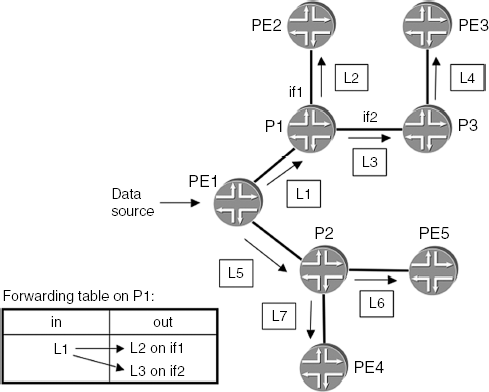6.3. P2MP LSP MECHANISMS
This section examines the forwarding and control plane mechanisms associated with P2MP LSPs. First we discuss how data are forwarded along a P2MP LSP. This is independent of the signaling protocol used to create the P2MP LSP. Then we discuss the two control plane mechanisms by which P2MP LSPs can be created: the RSVP-based scheme and the LDP-based scheme.
6.3.1. Forwarding plane mechanisms
A P2MP LSP [P2MP REQ, P2MP TE] has a single ingress router and multiple egress routers. This is illustrated in Figure 6.1. PE1 is the ingress router for the P2MP LSP. The egress routers are PE2, PE3, PE4 and PE5.
Figure 6.1. P2MP LSP forwarding operation

As can be seen in the figure, PE1 creates two copies of each packet arriving from the data source. One copy having the MPLS label value L1 is sent to P1 and another copy having the label value L5 is sent to P2. Routers PE1, P1 and P2 are called branch nodes. As can be seen, replication of MPLS packets occurs at these nodes.
Let us consider the packet forwarding process on P1. For each incoming packet belonging to the P2MP LSP, P1 makes two copies, one of which is sent to PE2 and the other to P3. Let us look at this process in more detail. Packets arrive at P1 having label L1. Looking at the inset of the figure, which shows the forwarding entry corresponding to the P2MP LSP installed on P1, it can be seen that P1 has ...
Get MPLS-Enabled Applications: Emerging Developments and New Technologies now with the O’Reilly learning platform.
O’Reilly members experience books, live events, courses curated by job role, and more from O’Reilly and nearly 200 top publishers.

